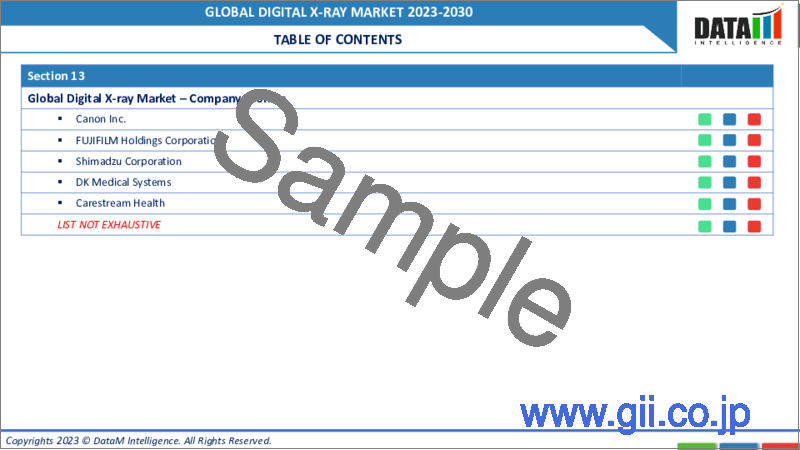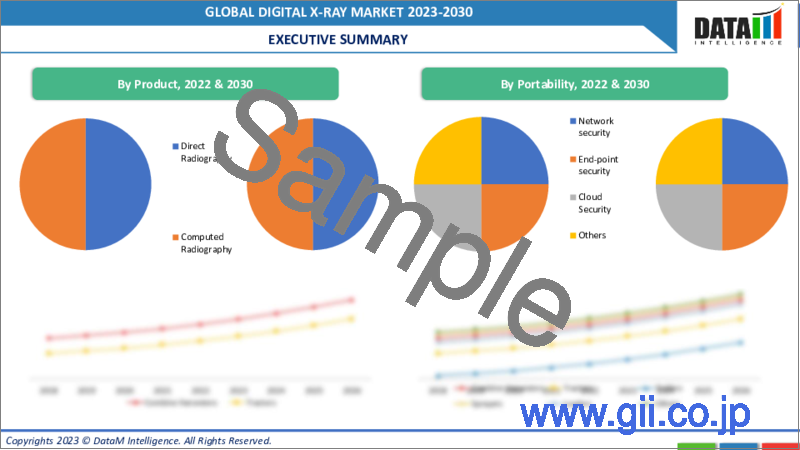|
|
市場調査レポート
商品コード
1138315
デジタルX線の世界市場-2022-2029Global Digital X-ray Market - 2022-2029 |
||||||
|
● お客様のご希望に応じて、既存データの加工や未掲載情報(例:国別セグメント)の追加などの対応が可能です。 詳細はお問い合わせください。 |
|||||||
| デジタルX線の世界市場-2022-2029 |
|
出版日: 2022年10月18日
発行: DataM Intelligence
ページ情報: 英文 170 Pages
納期: 約2営業日
|
- 全表示
- 概要
- 目次
市場力学
技術革新と製品開発の進展が市場成長の原動力となる
技術開拓は、デジタルX線市場の成長を促進する重要な要因です。デジタルX線システムは、画質、撮影時間、携帯性、検出器形状、ソフトウェアなどの要因により、高い需要があります。膨大な量のデータを分析し、患者を迅速に評価できるなどの利点が、デジタルX線装置の改良に対する需要を後押ししています。いくつかの企業は、性能と効率を高めるデジタル・ソリューションに取り組んでいます。診断品質の画像とスティッチング機能により、放射線技師は幅広い臨床アプリケーションに対応することができます。デジタルX線装置の市場は、技術革新と先端技術の開発によって活性化されています。2021年9月にGEヘルスケアがポータブルデジタルX線システム「AMX Navigate」をデビューさせたことは、この分野における最も新しい進歩のひとつです。同様に、米国食品医薬品局は2021年3月、ハイエンドのデジタルX線撮影と組み合わせた遠隔操作の透視システムであるCombi Diagnost R90について、Koninklijke Philips N.V.に510(k)認可を与えました。これは引き続きデジタルX線市場の主要な促進要因であり、予測期間中も市場を牽引すると予想されます。しかし、厳しい規制の枠組みや不利な償還政策、患者層における認知度の低さが、予測期間中の市場成長の妨げになると思われます。
デジタルX線システムの高コストが市場成長の妨げになる可能性が高い
デジタルX線技術は高価であり、かなりの先行投資を必要とするため、患者の手術費用を増加させます。これは、特に貧しい国々において、新しいシステムの迅速な導入に影響を及ぼします。中小病院の多くは、経営資源が限られているため、これらのシステムを導入する余裕がありません。医療機関は通常、第三者支払機関(メディケア、メディケイド、民間医療保険プランなど)を利用して、これらのシステムで行われる診断、スクリーニング、治療処置に発生する費用を補償しています。デジタルX線装置は高価であるため、エンドユーザーは再生品を購入する傾向が強く、新旧装置の販売に直接的な影響を及ぼしています。
本レポートでは、約66の市場データ表、61の図表、170ページにわたるデジタルX線システムの世界市場に関する情報を提供します。
目次
第1章 調査手法と範囲
- 調査手法
- 市場の範囲
第2章 主な動向と発展
第3章 エグゼクティブサマリー
- 製品別市場内訳
- ポータビリティ別市場内訳
- アプリケーション別市場内訳
- エンドユーザー別市場内訳
- 地域別市場内訳
第4章 市場力学
- 市場影響要因
- 促進要因
- 整形外科疾患の普及が市場成長の原動力
- デジタルX線装置の技術的進歩
- 抑制要因(Restraints
- 放射線被曝別副作用のリスク
- ビジネスチャンス
- 促進要因
- 影響度分析
第5章 産業分析
- ポーターのファイブフォース分析
- サプライチェーン分析
- プライシング分析
- 規制分析
- 診療報酬分析
第6章 COVID-19分析
- COVID-19の市場分析
- COVID-19以前の市場シナリオ
- COVID-19の現在の市場シナリオ
- COVID-19の後、または将来のシナリオ
- COVID-19の中での価格ダイナミクス
- 需要-供給スペクトラム
- パンデミック時の市場に関連する政府の取り組み
- メーカーの戦略的な取り組み
- まとめ
第7章 製品別
- コンピューテッドラジオグラフィー
- ダイレクトラジオグラフィー
第8章 ポータビリティ別
- ポータブルX線撮影装置
- モバイルX線システム
- ハンドヘルドシステム
- 固定式デジタルX線装置
- 床置き・天井埋め込み型
- 天吊り型システム
第9章 アプリケーション
- 歯科用
- マンモグラフィー
- 一般撮影
- 心臓血管
- 整形外科
- 胸部撮影
- その他
- 蛍光X線撮影
- その他
第10章 エンドユーザー
- 病院
- 診断センター
- その他
第11章 地域別
- 北米
- 米国
- カナダ
- メキシコ
- 南米
- ブラジル
- アルゼンチン
- その他の南米地域
- 欧州
- ドイツ
- 英国
- フランス
- スペイン
- イタリア
- その他の欧州地域
- アジア太平洋地域
- 中国
- インド
- 日本
- オーストラリア
- その他アジア太平洋地域
- 中東・アフリカ地域
第12章 競合情勢
- 競合シナリオ
- 競合他社の戦略分析
- 市況/シェア分析
- M&A(合併・買収)分析
第13章 企業プロファイル
- Siemens Healthineers
- 企業概要
- 製品ポートフォリオと説明
- 主なハイライト
- 財務概要
- GE Healthcare
- Hologic Inc.
- General Medical Merate SpA
- Koninklijke Philips NV
- Canon, inc
- FUJIFILM Holdings Corporation
- Shimadzu Corporation
- Carestream Health List not Exhaustive
第14章 DataM
Market Overview
Digital X-ray Market size was valued at USD 10,957.60 million in 2021 and is estimated to reach at a compound annual growth rate (CAGR) of 7.80% over the forecast period 2022 to 2029.
Digital X-Ray is an advanced version of the traditional X-ray where the X-ray-sensitive plates are used to capture data. The data is transferred to a computer instead of an intermediate cassette where the image is enhanced accordingly without the need for chemical processing. The global digital X-Ray market growth is driven by the increasing prevalence of orthopedic disease and cancer cases across the world. In addition, the increasing number of road accidents is also driving the growth of the market in the forecast period.
Market Dynamics: The increasing technological advancements and product development will drive the market growth
Technological developments are a critical driver in the digital X-ray market's growth. Digital X-ray systems are in high demand due to factors such as image quality, acquisition time, portability, detector form, and software. Benefits such as the ability to analyze massive amounts of data and evaluate patients quickly are driving demand for improved digital X-ray equipment. Several businesses are working on digital solutions that will boost performance and efficiency. With diagnostic-quality images and stitching functionality, radiologists may address a wide range of clinical applications. The market for digital X-ray systems is being boosted by innovation and the development of advanced technologies. The debut of AMX Navigate, a portable digital X-ray system by GE Healthcare in September 2021, is one of the most recent advances in this sector. Similarly, the US Food and Drug Administration granted 510(k) clearance to Koninklijke Philips N.V. in March 2021 for the Combi Diagnost R90, a remote-controlled fluoroscopy system combined with high-end digital radiography. This remains a major driver for the Digital X-Ray Market and is expected to drive the market during the forecast period. However, a stringent regulatory framework coupled with unfavorable reimbursement policies and a low awareness rate among the patient population will hamper the growth of the market in the forecast period.
The high cost of a digital X-ray system is likely to hamper the market growth
Digital X-ray technology is more expensive and requires considerable upfront investments, increasing the cost of the operation for patients. This has an effect on how quickly new systems are implemented, especially in poor countries. Most small and medium-sized hospitals cannot afford these systems due to their limited resources. Healthcare institutions typically use third-party payers (such as Medicare, Medicaid, or commercial health insurance plans) to compensate costs incurred in diagnostic, screening, and therapeutic procedures performed with these systems. Because of the high cost of digital X-ray systems, end users are more likely to purchase reconditioned systems, which has a direct impact on new and advanced system sales.
Market Segmentation: The Portable X-Ray system for the highest share in global Digital X-ray market
Because of the rising demand for patient diagnosis and monitoring in healthcare settings where it is difficult to move patients to the radiology department, the portable systems sector is predicted to grow at the highest CAGR during the forecast period (2021-2028). Portable systems are simple to set up and use, and they are widely available. This X-ray equipment can be put into service with little or no upfront investment. Patients in life-threatening situations who require rapid treatment and may require an on-the-spot diagnosis may benefit from the portable X-ray detectors, which have the ability to overcome geographic restrictions.
Geographical Penetration: North America is the dominating region during the forecast period.
North America is estimated to hold a major share of the Digital X-Ray Market, and it is expected to show a similar trend over the forecast period. The growing burden of chronic diseases in the region, as well as the increasing usage of advanced technologies in healthcare systems, is driving the digital X-Rays devices market in North America. According to GLOBOCON 2020, there will be 2,281,658 new cancer cases diagnosed in the United States year 2020, with 612,390 fatalities. According to the Arthritis Foundation Fact Sheet, 2019, the number of adults in the United States with doctor-diagnosed arthritis is expected to reach 78.4 million by 2040, accounting for 25.9% of all adults in the country. The increased prevalence of chronic diseases increases the demand for accurate diagnosis and a treatment plan that is both efficient and timely from healthcare providers. Thus, these factors are driving the growth of the market in the North American region.
Competitive Landscape:
The digital x-ray market is highly competitive with the presence of local as well as global companies. Some of the key players contributing to the growth of the market include Siemens Healthineers, Koninklijke Philips N.V., GE Healthcare, Canon, Inc., Carestream Health, FUJIFILM Holdings Corporation, Shimadzu Corporation, Hologic Inc. Fujifilm Holdings Corporation. The major players are adopting several growth strategies such as product launches, acquisitions, and collaborations, which are contributing to the growth of the digital x-ray market globally. For instance,
In Oct 2020, the FDA has approved Siemens Healthineers' Ysio Max digital radiography system, which includes new detectors and usability features that improve imaging and speed up exams.
In Nov 2020, Siemens Healthineers launched a ceiling-mounted digital radiography system Multix Impact C. They also launched a new version of the established floor-mounted parent system named MULTIX Impact VA20.
COVID-19 Impact: Negative impact on the global Digital X-ray Market
In 2020, the COVID-19 pandemic had a negative impact on the economy and posed numerous obstacles to clinical healthcare practitioners and patients all across the world. COVID-19 has also had an impact on numerous levels of the value chain, owing to the stringent lockdowns imposed by most governments. Due to modern packaging rules and country-imposed lockout procedures, the turnaround time for product and service delivery has also been impacted. All of these variables have a negative impact on digital X-ray system manufacturing and supply chains. COVID-19, on the other hand, has opened up new possibilities for digital X-ray makers and healthcare providers. Chest imaging has been explored as an alternate option for individuals with suspected or probable COVID-19 in situations when laboratory testing (RT-PCR) is not available, or results are delayed or initially negative. Imaging tests such as chest radiography, CT scans, and lung ultrasounds have been used to supplement clinical evaluation and laboratory data in the management of COVID-19 patients. Chest radiography, according to the WHO, can aid in the dynamic evaluation of COVID-19 pneumonia and associated consequences. On a bedside chest radiograph, the resolution or development of lung consolidation can aid caregivers in making better therapeutic management decisions. The management of a pneumothorax or pneumomediastinum might also be aided by chest imaging.
Siemens Healthineers
Overview: Siemens Healthineers AG is a Germany-based company that supplies technology to the healthcare industry. The Company offers a wide range of products and services in the fields of diagnostic and therapeutic imaging, laboratory and point of care diagnostics, and molecular medicine.
Product Portfolio:
Multix Impact- Multix Impact is a radiographic digital X-ray system developed by Siemens Healthineers. It is an advanced system that is based on integrated intelligence to assist the user. It is economical and effective.
The global Digital X-ray market report would provide an access to approximately 66 market data tables, 61 figures and 170 pages
Table of Contents
Scope and Methodology
- 1.1. Research Methodology
- 1.2. Scope of the Market
2. Key Trends and Developments
3. Executive Summary
- 3.1. Market Snippet by Product
- 3.2. Market Snippet by Portability
- 3.3. Market Snippet by Application
- 3.4. Market Snippet by End-User
- 3.5. Market Snippet by Region
4. Market Dynamics
- 4.1. Market impacting factors
- 4.1.1. Drivers
- 4.1.1.1. The prevalence of orthopedic cases will drive the market growth.
- 4.1.1.2. Technological advancements in digital X-ray devices
- 4.1.2. Restraints
- 4.1.2.1. Risk of adverse effects from radiation exposure
- 4.1.3. Opportunities
- 4.1.1. Drivers
- 4.2. Impact analysis
5. Industry Analysis
- 5.1. Porter's five forces analysis
- 5.2. Supply Chain Analysis
- 5.3. Pricing Analysis
- 5.4. Regulatory Analysis
- 5.5. Reimbursement Analysis
6. COVID-19 Analysis
- 6.1. Analysis of Covid-19 on the Market
- 6.1.1. Before COVID-19 Market Scenario
- 6.1.2. Present COVID-19 Market Scenario
- 6.1.3. After COVID-19 or Future Scenario
- 6.2. Pricing Dynamics Amid Covid-19
- 6.3. Demand-Supply Spectrum
- 6.4. Government Initiatives Related to the Market During Pandemic
- 6.5. Manufacturers Strategic Initiatives
- 6.6. Conclusion
7. By Product
- 7.1. Introduction
- 7.1.1. Market size analysis, and y-o-y growth analysis (%), By Product Segment
- 7.1.2. Market attractiveness index, By Product Segment
- 7.2. Computed Radiography*
- 7.2.1. Introduction
- 7.2.2. Market Size Analysis, US$ Million, 2020-2029 And Y-O-Y Growth Analysis (%), 2021-2029
- 7.3. Direct Radiography
8. By Portability
- 8.1. Introduction
- 8.1.1. Market size analysis, and y-o-y growth analysis (%), By Portability Segment
- 8.1.2. Market attractiveness index, By Portability Segment
- 8.2. Portable X-Ray Systems*
- 8.2.1. Introduction
- 8.2.2. Market Size Analysis, US$ Million, 2020-2029 And Y-O-Y Growth Analysis (%), 2021-2029
- 8.2.3. Mobile X-Ray Systems
- 8.2.4. Handheld Systems
- 8.3. Fixed Digital X-Ray Systems
- 8.3.1. Floor-to-ceiling Mounted Systems
- 8.3.2. Ceiling Mounted Systems
9. Application
- 9.1. Introduction
- 9.1.1. Market size analysis, and y-o-y growth analysis (%), By Application Segment
- 9.1.2. Market attractiveness index, By Application Segment
- 9.2. Dental*
- 9.2.1. Introduction
- 9.2.2. Market Size Analysis, US$ Million, 2020-2029 And Y-O-Y Growth Analysis (%), 2021-2029
- 9.3. Mammography
- 9.4. General Radiography
- 9.4.1.1. Cardiovascular
- 9.4.1.2. Orthopedic
- 9.4.1.3. Chest Imaging
- 9.4.1.4. Others
- 9.5. Fluoroscopy
- 9.6. Others
10. End-User
- 10.1. Introduction
- 10.1.1. Market size analysis, and y-o-y growth analysis (%), By End-User Segment
- 10.1.2. Market attractiveness index, By End-User Segment
- 10.2. Hospitals*
- 10.2.1. Introduction
- 10.2.2. Market Size Analysis, US$ Million, 2020-2029 And Y-O-Y Growth Analysis (%), 2021-2029
- 10.2.3. Diagnostic Centers
- 10.2.4. Others
11. By Region
- 11.1. Introduction
- 11.1.1. Market Size Analysis, And Y-O-Y Growth Analysis (%), By Region
- 11.1.2. Market Attractiveness Index, By Region
- 11.2. North America
- 11.2.1. Introduction
- 11.2.2. Key region-specific dynamics
- 11.2.3. Market Size Analysis, And Y-O-Y Growth Analysis (%), By Product
- 11.2.4. Market Size Analysis, And Y-O-Y Growth Analysis (%), By Portability
- 11.2.5. Market Size Analysis, And Y-O-Y Growth Analysis (%), By Application
- 11.2.6. Market Size Analysis, And Y-O-Y Growth Analysis (%), By End-User
- 11.2.7. Market Size Analysis, And Y-O-Y Growth Analysis (%), By Country
- 11.2.7.1. U.S.
- 11.2.7.2. Canada
- 11.2.7.3. Mexico
- 11.3. South America
- 11.3.1. Introduction
- 11.3.2. Key Region-Specific Dynamics
- 11.3.3. Market Size Analysis, And Y-O-Y Growth Analysis (%), By Product
- 11.3.4. Market Size Analysis, And Y-O-Y Growth Analysis (%), By Portability
- 11.3.5. Market Size Analysis, And Y-O-Y Growth Analysis (%), By Application
- 11.3.6. Market Size Analysis, And Y-O-Y Growth Analysis (%), By End-User
- 11.3.7. Market Size Analysis, And Y-O-Y Growth Analysis (%), By Country
- 11.3.7.1. Brazil
- 11.3.7.2. Argentina
- 11.3.7.3. Rest of South America
- 11.4. Europe
- 11.4.1. Introduction
- 11.4.2. Key Region-Specific Dynamics
- 11.4.3. Market Size Analysis, And Y-O-Y Growth Analysis (%), By Product
- 11.4.4. Market Size Analysis, And Y-O-Y Growth Analysis (%), By Portability
- 11.4.5. Market Size Analysis, And Y-O-Y Growth Analysis (%), By Application
- 11.4.6. Market Size Analysis, And Y-O-Y Growth Analysis (%), By End-User
- 11.4.7. Market Size Analysis, And Y-O-Y Growth Analysis (%), By Country
- 11.4.7.1. Germany
- 11.4.7.2. U.K.
- 11.4.7.3. France
- 11.4.7.4. Spain
- 11.4.7.5. Italy
- 11.4.7.6. Rest of Europe
- 11.5. Asia Pacific
- 11.5.1. Introduction
- 11.5.2. Key Region-Specific Dynamics
- 11.5.3. Market Size Analysis, And Y-O-Y Growth Analysis (%), By Product
- 11.5.4. Market Size Analysis, And Y-O-Y Growth Analysis (%), By Portability
- 11.5.5. Market Size Analysis, And Y-O-Y Growth Analysis (%), By Application
- 11.5.6. Market Size Analysis, And Y-O-Y Growth Analysis (%), By End-User
- 11.5.7. Market Size Analysis, And Y-O-Y Growth Analysis (%), By Country
- 11.5.7.1. China
- 11.5.7.2. India
- 11.5.7.3. Japan
- 11.5.7.4. Australia
- 11.5.7.5. Rest of Asia Pacific
- 11.6. Middle East and Africa
- 11.6.1. Introduction
- 11.6.2. Key Region-Specific Dynamics
- 11.6.3. Market Size Analysis, And Y-O-Y Growth Analysis (%), By Product
- 11.6.4. Market Size Analysis, And Y-O-Y Growth Analysis (%), By Portability
- 11.6.5. Market Size Analysis, And Y-O-Y Growth Analysis (%), By Application
- 11.6.6. Market Size Analysis, And Y-O-Y Growth Analysis (%), By End-User
12. Competitive Landscape
- 12.1. Competitive scenario
- 12.2. Competitor strategy analysis
- 12.3. Market positioning/share analysis
- 12.4. Mergers and acquisitions analysis
13. Company Profiles
- 13.1. Siemens Healthineers*
- 13.1.1. Company Overview
- 13.1.2. Product Portfolio and Description
- 13.1.3. Key Highlights
- 13.1.4. Financial Overview
- 13.2. GE Healthcare
- 13.3. Hologic Inc.
- 13.4. General Medical Merate SpA
- 13.5. Koninklijke Philips NV
- 13.6. Canon, inc
- 13.7. FUJIFILM Holdings Corporation
- 13.8. Shimadzu Corporation
- 13.9. Carestream Health List not Exhaustive*
14. DataM
- 14.1. Appendix
- 14.2. About us and services
- 14.3. Contact us




